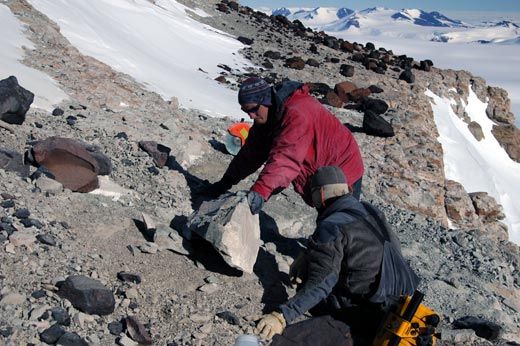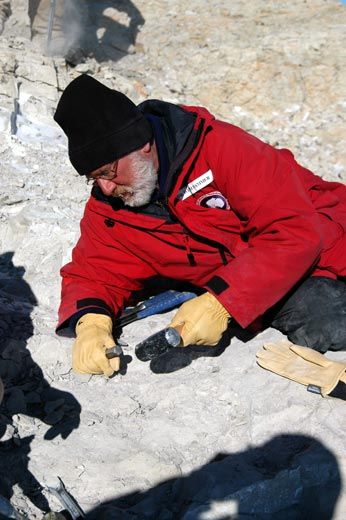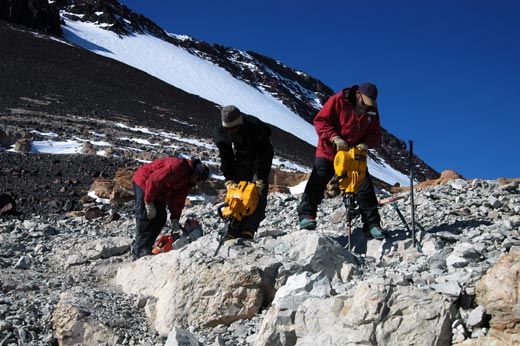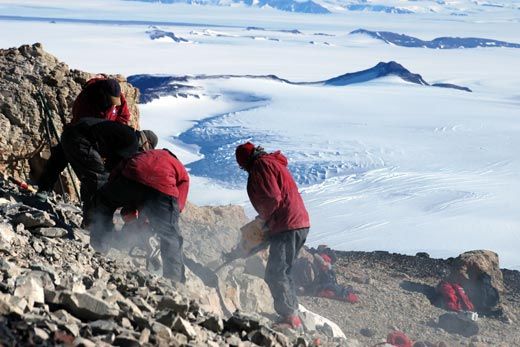Bones to Pick
Paleontologist William Hammer hunts dinosaur fossils in the Antarctic
/https://tf-cmsv2-smithsonianmag-media.s3.amazonaws.com/filer/hammer_main_dec07_631.jpg)
Most of Antarctica's fossils lie buried beneath glaciers, but prime bits of fossil-bearing sedimentary rock jut thousands of feet above the ice. Geologic forces have created mountains where once an ancient river flowed, and it is here intrepid dinosaur hunters, such as William Hammer, come to search out the past. He's made the journey from Augustana College in Rock Island, Illinois, to Antarctica seven times in the last 30 years.
Finding dinosaur fossils isn't all that hard, but extracting them is. Hammer and his colleagues camp out on a glacier for about two months during the Antarctic summer—with -20 degree temperatures and 24-hour daylight—500 miles from the nearest medical aid. Though some of Hammer's digs are accessible by snowmobile, the dinosaur site on the side of Mount Kirkpatrick can be reached only by helicopter and only when the weather cooperates. Then they have to hope that they'll be able to start the gas-powered jackhammers, drills, and saws they use to extract large chunks of rock. This is a difficult task most days, made worse when the tools' plastic casings get so cold and brittle that they break.
Some days are better than others, especially when it comes to transportation. During his last trip, there was a problem with one of the helicopters, Hammer explains. "They said they did a 'hard landing,' but when the landing gear goes through the bottom of the helicopter, to me, that's a crash."
Given the conditions, Hammer doesn't search for anything in particular. "We look for whatever we can find," he says, and they've made some amazing finds: The fossilized bones of a 22-foot-long meat-eating crested dinosaur, called Cryolophosaurus elloti, were covered with teeth from small theropods (relatives of Tyrannosaurus rex) that had scavenged the large polar dinosaur after its death. Plant remains nearby and the sediments in which the bones were buried indicate that the dinosaur probably lived at a time when the region's climate was cool temperate, like coastal Washington state but not as wet, Hammer says. And though the bones can't tell him much about the animal's physiology or behavior, he says, "the dinosaurs and other animals we find do not show any special adaptations for cold or darkness," unlike some polar dinosaur remains found in Australia.
There have been plenty of non-dino fossils, too, especially from the time period before dinosaurs lived. These have included "weird amphibians with three-foot-long skulls that look like toilet lids," Hammer says, and his favorite, the front end of the snout of another amphibian with three-inch-long fangs.
Despite the weather, altitude, and occasionally scary rides in ski-planes and helicopters, Hammer keeps going south to search for more. He's hoping to return in the next year or two so he can extract some bones that he found during his last expedition. "It's kind of like a trip to outer space," he says, "but you don't have to wear space suits, just a lot of clothes."
/https://tf-cmsv2-smithsonianmag-media.s3.amazonaws.com/accounts/headshot/Sarah-Zielinski-240.jpg)




/https://tf-cmsv2-smithsonianmag-media.s3.amazonaws.com/accounts/headshot/Sarah-Zielinski-240.jpg)